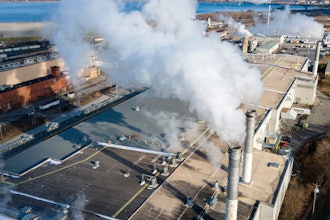Total U.S. crude oil production averaged 7.5 million bbl/d in 2013, 967,000 barrels per day (bbl/d) higher than 2012 and the highest level of U.S. production since 1989. In December 2013, U.S. crude oil production reached 7.9 million barrels per day (bbl/d), according to EIA's recently released December 2013 Petroleum Supply Monthly, an increase of 785,000 bbl/d (11%) compared with December 2012.
The 15% increase in U.S. production from 2012 to 2013 was the largest annual percentage increase since 1940. The increase in domestic production supported high refinery utilization rates, reduced U.S. imports of crude oil, and changed domestic and global crude oil and petroleum product trade flows.
U.S. crude oil production gains were geographically concentrated in Texas and North Dakota, which together accounted for 83% of U.S. production growth (Figure 1). Production in the Eagle Ford formation in South Texas reached an estimated 1.22 million bbl/d in December 2013. Production from the Bakken formation in North Dakota and Montana averaged 0.9 million bbl/d in 2013 and reached 1 million bbl/d in November 2013. Other states with significant production increases included Oklahoma, New Mexico, and Colorado.
Seven states and the Gulf of Mexico had lower crude oil production in 2013 than in 2012. The Gulf of Mexico and Alaska accounted for most of the decline, each falling by 2%.
Increased domestic production provided U.S. refineries with additional volumes of cost-advantaged crude oil, supporting high refinery runs. Monthly U.S. refinery utilization averaged 88% in 2013 and exceeded 90% for six months of the year. Gross inputs to atmospheric crude oil distillation (CDU) units increased 355,000 bbl/d (2%) over 2012 levels.
As domestic production rose during 2013, crude oil imports were displaced and net imports fell to 7.6 million bbl/d – the lowest level since 1996. U.S. net imports of crude oil declined by 861,000 bbl/d (10%) in 2013 and at year-end were 30% below the June 2005 peak of 10.7 million bbl/d. The share of U.S. crude oil demand supplied by domestic production rose sharply in 2013, averaging 49% compared with 43% in 2012. U.S. crude oil production was 6% higher than net imports in the fourth quarter of 2013.
Looking ahead, EIA's March Short-Term Energy Outlook (STEO) projects U.S. production to average 8.4 million bbl/d in 2014, an increase of 0.9 million bbl/d. In 2015, STEO projects U.S. oil production to rise an additional 0.8 million bbl/d to average 9.2 million bbl/d, close to the 1970 historical peak U.S. annual production of 9.6 million bbl/d. STEO projects crude oil production growth to be concentrated primarily in the Bakken, Eagle Ford, and Permian formations through 2015. STEO also projects Gulf of Mexico production to rise in the near term, increasing 140,000 bbl/d in 2014 and an additional 210,000 bbl/d the following year to average 1.6 million bbl/d in 2015. Projected Gulf of Mexico production increases result from 8 projects expected to come online in 2014 and an additional 10 in 2015.
March Drilling Productivity Report indicates continuing oil production growth in key producing regions
The March update to the Drilling Productivity Report (DPR) indicates continuing oil production growth in the key oil producing regions. EIA expects combined oil production in the Bakken, Niobrara, Permian, and Eagle Ford to increase by 66,000 barrels per day (bbl/d) in April 2014 compared with the previous month. In the Bakken region, newly completed wells continue to show higher initial production rates. Despite the slowdown in completion work because of cold weather this winter, future production growth in the region should not be dramatically reduced. In the Permian region, state production data indicate that horizontal drilling is starting to increase the initial production per average well and helping grow total oil production in the region. With the latest production data available from the Railroad Commission of Texas, DPR revised the efficiency of the average rig higher, resulting in expected production growth of 11,000 bbl/d in April.
Gasoline and diesel fuel prices both increase
The U.S. average retail price of regular gasoline increased three cents to $3.51 per gallon as of March 10, 2014, 20 cents less than the same week last year. The Rocky Mountain and West Coast prices both increased by five cents this week, to $3.44 and $3.76 per gallon, respectively. Midwest prices rose by four cents to $3.54 per gallon. The Gulf Coast average price gained three cents to $3.25 per gallon, while prices on the East Coast rose two cents to $3.49 per gallon.
The U.S. average price for diesel fuel was up by half a cent, holding at $4.02 per gallon for a third consecutive week, but down seven cents from the same time last year. The Gulf Coast price increased by two cents to $3.81 per gallon. The Rocky Mountain price also increased by two cents, reaching $4.00 per gallon, a first since the same week last year. The East and West Coast prices were each up by less than half a cent, to remain at $4.16 and $4.04 per gallon, respectively. The Midwest posted the only decline, falling one cent to $4.01 per gallon.
Residential heating oil and propane prices decrease
Residential heating oil prices decreased 3 cents per gallon to reach a price of nearly $4.20 per gallon during the period ending March 10, 2014. This is almost 14 cents per gallon higher than last year's price at this time. Wholesale heating oil prices fell by 4 cents per gallon last week to $3.31 per gallon.
The average residential propane price decreased by 13 cents per gallon last week to $3.17 per gallon, 85 cents per gallon higher than the same period last year. Wholesale propane prices decreased by 8 cents per gallon to almost $1.43 per gallon as of March 10, 2014.
Propane inventories fall
U.S. propane stocks fell by 1.1 million barrels last week to 26.1 million barrels as of March 7, 2014, 16.9 million barrels (39.4%) lower than a year ago. Midwest inventories decreased by 0.9 million barrels. Both Gulf Coast and Rocky Mountain/West Coast inventories decreased by 0.1 million barrels, while East Coast inventories increased by 0.1 million barrels. Propylene non-fuel-use inventories represented 13.3% of total propane inventories.






















